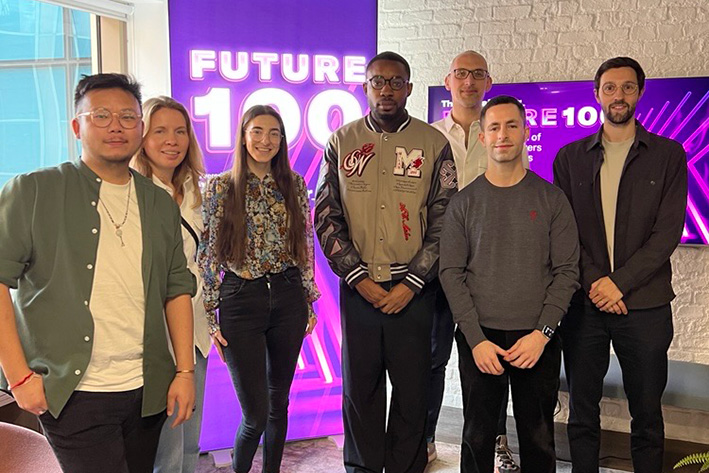Future 100: ‘Chaos provides opportunity’ in era of omnichannel planning and AI


Omnichannel planning is crucial, but it’s a challenge to stay up to date with the latest developments of all channels and understand the nuances of each in an age of media fragmentation.
That was one conclusion reached at a recent roundtable event hosted by The Media Leader and featuring a group of Future 100 Club participants, who also discussed how AI can play a role in addressing media fragmentation.
As Maria Shcheglakova, TiVo’s director of global marketing, CTV and data advertising, pointed out: “Brands don’t come and say let’s spend on this channel, that channel; they want overall reach!”
“Omnichannel is a big priority for an established brand,” said Babs Sotande-Peters, senior manager, global programmatic and innovation, at Team X, Omnicom’s Mercedes-Benz division. He added the industry needs “an efficient way to judge the value of that”.
But in the modern media ecosystem, this is complicated work.
For James Weinberg, executive director, media and product, at T&Pm, the way TV is traded remains “horribly archaic”. Meanwhile, there is “a big under-investment in audio”.
Addressing recent debate around large brands potentially over-investing in social media, Weinberg added simply: “You can’t deny the role of Meta on a plan.”
Given the proliferation of channels to buy against, it’s crucial for agencies to understand all the latest research in order for them to prove their value to advertisers — and sometimes that involves difficult conversations.
Matthew Chew, director and Europe influencer media lead at Studio X, WPP’s Coca-Cola unit, thinks it’s about “using the right picture to present to your clients”. Sotande-Peters agreed that agencies should be providing “best-in-class consultancy”.
Tim Bond, associate director at Ipsos UK, went even further, suggesting that agencies have a need to be “professionally argumentative”.
Fragmentation for the better?
But the proliferation of channels isn’t necessarily a bad thing, as it’s often portrayed to be.
“It’s fragmenting — but for the better,” said Chew. “If it means we are reaching audiences in different ways, that can only be a benefit to advertisers.”
For instance, while it’s clear that linear TV is in decline, agencies and brands can and should think differently about their media mix, according to Ben Titchener, director of sales and planning at Vevo. “You can’t get them back to your platforms,” he said. “You’ve got to reach them where they want to be reached.”
For Sotande-Peters, this means finding a way to look at overall impact, not just individual channels. He called on the industry to “create new definitions of impact rather than hardline metrics”.
This was echoed by Titchener, who agreed that “when you review a campaign at the end, it’s not one single piece of data”.
But the multitude of channels can often lead to a reduced focus on long-term brand-building, warned Teodora Tepavicharova, UK director of programmatic strategy at Condé Nast.
In her experience, sometimes publisher, agency and brand all work in silos and wonder why something doesn’t work.
“The problem is you don’t have a strategy,” she explained. “We need to think more long-term.”
Hyper-personalisation: friend or foe?
As channels evolve and targeting tools improve across digital platforms, so does the ability to hyper-personalise. But it’s not a straightforward yes-no discussion, according to the roundtable.
“If you’re a big brand, they expect you to do big things,” Shcheglakova suggested. “But I would be impressed if I get an ad for a local plumber!”
It’s a fine balance, since the view of the industry is often different to that of the general public. “When people I know get a hyper-personalised campaign, they freak out,” Tepavicharova shared.
For Bond, it’s simple. “What is targeting? It’s not generational, age, or being able to say: ‘Tim, I’ve got this ad for you,’” he explained. “It’s about context.
“If you see something that’s more personal to you, you’re more likely to pay attention.”
AI beyond efficiencies
The group also explored the part AI plays in their role and the wider industry.
Much of what AI can currently do now relates to efficiency and simplification. After all, “a lot of what we do is stuck in the dark ages”, Weinberg acknowledged.
For Bond, the focus must be on “turning hype into actual value”.
Sotande-Peters cautioned that, for brands, it’s about “striking the balance between the services that will help them and their desire to remain authentic to their brand voice”.
Meanwhile, Chew highlighted two potential pitfalls that agencies must stay educated on: the possibility of biases within the AI and the need to take the nuances of different languages into account, particularly when it’s used to create global work.
Tepavicharova admitted that publishers appear behind on AI’s adoption compared with the agencies in the room. “For premium publishers, we’re still at educational stage,” she said. “How we can balance that with quality of journalism, quality of content?”
But none seemed particularly concerned about the continuing debate over AI taking their jobs.
While Shcheglakova highlighted the creation of new roles thanks to AI, Bond observed: “Even when AI gets better than it is now, an AI by itself and a human by itself is never going to beat a human who can use AI.”
Shcheglakova agreed: “I hope to see more fun experience where AI can power it, but I don’t think it can substitute human creativity.”
As AI redefines the work agencies do, there’s an opportunity to “get rid of the middle man”, thus resulting, as Titchener suggested, in more money going back to the media owner. Indeed, he believes it’s a “chance to reaffirm your value proposition in the market”.
Sotande-Peters concluded: “Chaos provides opportunity in all walks of life.”
Future 100: Working with data and AI requires balanced, human-centric approach




